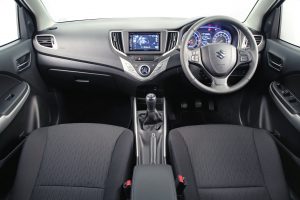
There can be no denying the popularity of small hatchbacks among South African buyers. Volkswagen’s Polo and Vivo have found a comfortable nesting spot at the top of the local sales charts, while equally worthy contenders from Ford (Fiesta), Opel (the excellent Corsa) and Hyundai (i20) all lure steady streams of customers into their respective dealerships. On top of these mainstream offerings, other players are also attempting to break into this “supermini” segment: Kia fields the pretty Rio, Chevrolet has a high-value offering in the Sonic, Toyota’s Yaris attempts to regain the popularity of its predecessor, and Peugeot’s 208 mounts yet another strong challenge.
It really is no wonder that the Suzuki Swift still struggles to pose a really significant threat against such formidable opponents, then. While the Swift range is endowed with sparkling driving dynamics, good looks and a strong value proposition, it suffers from two drawbacks when compared to the establishment: it’s quite severely hamstrung in the practicality stakes (thanks to its compromised luggage compartment), and it appears a little dated inside the cabin (especially when compared to the Corsa and Polo, both of which are awash in soft-touch loveliness, high-tech gadgets, and colourful touch screens). The Swift might be great fun to drive, but that’s not really what the majority of buyers seem to crave these days…
Fortunately, it’s time for Suzuki to release a new generation of superminis, leading the charge with an all-new entrant, called the Baleno. It is a fresh design, built upon a new platform (which will also underpin the next-generation Swift), and is designed expressly to appeal to the more rational buyers, leaving the Swift as the quirkier and less pragmatic alternative. The Baleno features a much larger cargo capacity than its smaller brother (growing to 355 litres with the rear seats in use), offers a lot more cabin space (with class-leading rear legroom), and boasts enough equipment upgrades to bring it in line with its competitors.
It’s also quite a lot smarter under the skin, because the new platform manages to shed an impressive amount of weight. Extensive use of high-strength steel and a simplified body structure results in a kerb weight of only 915 kg in basic trim – that’s lighter than the featherweight (and much smaller) Toyota Etios, and even comes in 11% below the standard set by the smaller Swift. Having less lard to drag about bodes well for fuel efficiency, performance, and driving dynamics, while the high tensile steel in use means that the Baleno doesn’t compromise on occupant safety – it carries a 4-star Euro-NCAP crash test rating.
While the bodyshell is brand new, some elements of the Baleno will be familiar from other models in the Suzuki family. The drivetrain is carried over from the Swift, Ciaz and Ertiga: South Africa will only receive a 1.4-litre, normally-aspirated four cylinder mill, mated to either a 5-speed manual gearbox or a 4-speed automatic. There’s no chance of the latest turbocharged BoosterJet engines coming to South Africa any time soon, so we’ll just have to make do with the 68 kW and 130 Nm on offer. At any rate, this engine is well-proven to be perky and durable, as well as exceptionally fuel-efficient: official average consumption is quoted as 5.1 ℓ/100 km with a manual gearbox or 5.4 ℓ/100 with the self-shifter.

Equipment levels are on par with its main competitors, with the entry-level GL (only available in manual form) featuring electric windows all round, remote-controlled central locking, manual air conditioning, (electric) power-assisted steering, a colour TFT information display between the speedometer and rev-counter, a USB/MP3/Bluetooth compatible audio system with 6 speakers and steering wheel-mounted controls, and two airbags.
GLX specification ups the airbag count to six, and adds 16-inch alloy wheels, disk brakes for the rear wheels, HID headlamps, front fog lamps, automatic air-con, cruise control (with its buttons on a steering wheel which is now wrapped in leather), keyless entry-and-start, rear parking sensors, a 6.2-inch touch-screen multimedia interface with optional navigation, and extra brightwork on both the exterior and the dashboard.

Those are the technical details and specification sheets, but what’s the Baleno like to drive? Here, the news is mostly good. Suzuki hasn’t lost their touch in making ordinary cars feel special to the driver, because the Baleno is just about as enjoyable to pilot as its Swift sibling. The suspension is tuned for comfort rather than sporty handling, yet manages to navigate corners with surprising eagerness, while the steering is accurate and responsive. It’s stable at freeway speeds, and cross winds fail to upset it to any significant degree. Its reduced kerb weight doesn’t translate into a noisy cabin either, with well-contained noise levels and negligible transmission of vibrations to the occupants.
The power plant is also entirely adequate, with a reasonably wide spread of torque complimented by smartly chosen gear ratios and a smooth, sweet gearchange action. The Baleno’s performance won’t set the tarmac alight with tyre-shredding brutality, but the claimed 0 – 100 km/h sprint in 10.9 seconds (in manual form), combined with a top speed of 180 km/h, gives it a comfortably mid-pack level of punch. It certainly didn’t feel short of breath on our launch route near Port Elizabeth, but might face more of a challenge at Gauteng altitudes.
All these attributes translate into a compact hatchback which suits its intended place in the market to perfection. It falls a little bit short of being remarkable in any way (lightweight construction aside), but offers such a broad spread of all-round competence that its appeal is difficult to deny. The fact that it’s really strong on value simply rounds out a very enticing package, and one which is sure to make its opponents (and the public) sit up and take notice.
Suzuki Baleno Range:
Baleno 1.4 GL R 199 000
Baleno 1.4 GLX Manual R 229 900
Baleno 1.4 GLX Auto R 244 900



